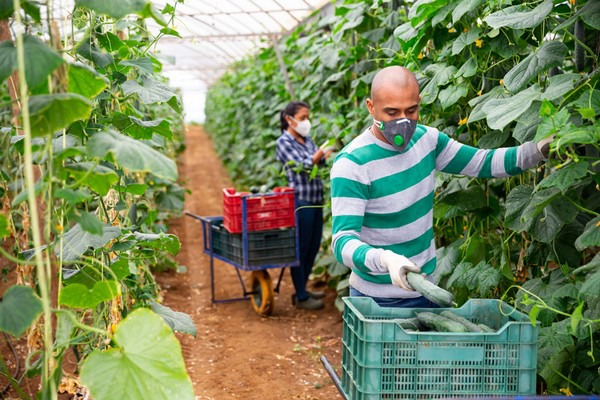Six months into the pandemic, the fresh produce industry has felt the economic impact of investing in greater resources around COVID-related safety—whether it’s educating workers, implementing physical distancing and more. But, as this week’s PMA virtual town hall discussed: what effect have these resources had on the industry?
While sanitation and food safety have long been a significant focus for the fresh produce industry, the pandemic shone a spotlight on simple practices the industry could do even better such as masking all the time or putting up barriers. “And these hygienic practices are essentially free. They’re small investments that have a huge payback for companies that take them seriously,” said Jim Byron, CEO of Ponte Vedra Beach, FL-based Xgenex.
 Furthermore, before long, these hygiene practices could become commonplace. “Early on in the poultry industry, we’d have our temperature taken when we’d go into a plant. Now going into plants, the first time I walked in the door, I got to the end of the hallway and they waved me through. I asked about my temperature and they’d already taken five temperature readings as I was walking down that hall,” said Byron.
Furthermore, before long, these hygiene practices could become commonplace. “Early on in the poultry industry, we’d have our temperature taken when we’d go into a plant. Now going into plants, the first time I walked in the door, I got to the end of the hallway and they waved me through. I asked about my temperature and they’d already taken five temperature readings as I was walking down that hall,” said Byron.
Playing the long game
That said, investments made now in food safety will have long-term gain. “It will take some time to get through this pandemic and understand how to get our work done in light of the presence of this virus,” said Byron. “Whatever you invest in now will work for you for a long time.”
This includes the role of technology, which could be increasingly crucial pre- and post-harvest down the road. “The return on investment is going to come from technology,” said Byron, who notes with the onset of the pandemic, produce processing plants went largely into lockdown with extreme controls as to who entered and exited the facilities. Again turning to poultry, Byron noted for instance that one poultry customer wanted to maximize the use of technology. “We accelerated some projects we were doing and we remotely accessed things that were going on in the plant without having to send people in,” he added.
Of course, throughout the pandemic, while everyone in the supply chain absorbed significant additional costs, it seemed like grower shippers were impacted disproportionately by factoring in things multiple safety measures. This impacted the bottom line and affected how efficient processes were. “On the growing side for example, we spaced our employees further. Some growers harvested every other row and then turned the machines around to come back for the missed rows. This added tremendous time to the harvest cycle,” said Robert Verloop, COO/GM of Coastline Family Farms in Salinas, CA.
 © Dreamstime
© Dreamstime
Investment in labor
Those measures also included adding significant effort into re-educating employees on COVID-19 prevention practices—such as proper physical distancing. To do that, the grower-shipper association in Salinas turned to public health and local hospitals to help employees adopt these practices in the workplace and at home. “As a result, we had additional testing areas specifically for agriculture workers, quicker turnarounds, etc. These are all costs though that came into the system that seemed hidden at times but eventually filtered down to the cost of doing business,” said Verloop.
That said, the investments made in recent years in labor have already been paying off, said Verloop. “The fundamentals are there in sanitation practices and we’re seeing the return on that investment from the last 10 years. Employees understanding of food safety has been greatly elevated,” he said.
At the same time, there was also the increased pressure on maintaining the food safety standards that North America had largely developed. “Because of the COVID crisis, what’s clear is that other countries outside the U.S. have an increased interest in exporting their food products to the U.S. But with that interest also comes risk,” says Tania Martinez, vice-president of Demos Global based in Miami, FL. “We’re seeing the need for them to guarantee that in the supply chain that these products complied with U.S. standards. There are good companies out there but there are also companies who don’t care about food safety.”
Discovering opportunities
At the same time, COVID-19 unveiled some possible new distribution opportunities. “The Food Box program demonstrated that there was a huge need there for our product and it went beyond traditional distribution mechanisms,” said Verloop.
He noted that typically donations made to food banks from growers can often be products that are long on inventory and need to be moved out. “This program demonstrated that with an economic incentive, we’re going to recover our growing costs and our other costs that we’re having to absorb, and that we can serve people who are underserved. This will identify areas where we can do a better job of distributing our products and also supporting farm families,” said Verloop.
It also unearthed some potential weaknesses in the industry and companies. “We need to look at our business models and see if we can sustain our model should something else like COVID come along,” says Robert. “And as an industry, we need to be more prepared for crises. As we went into COVID we found out there weren’t enough masks to do what we needed for example,” says Verloop. “In California, we’re prepared for earthquakes. But we’re not prepared for this the way we should be.”










